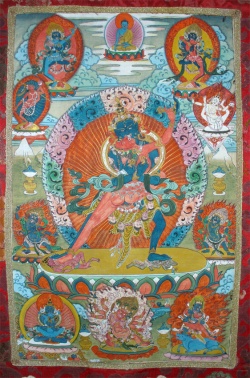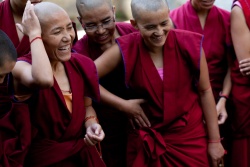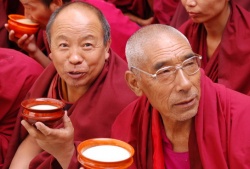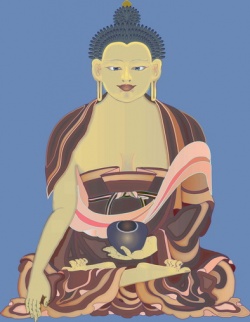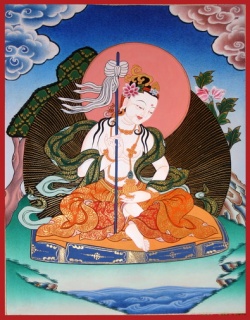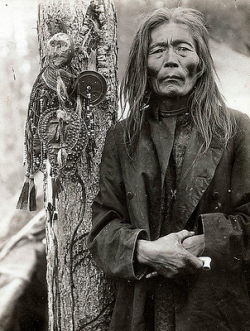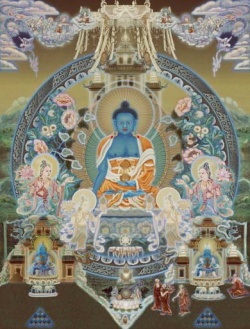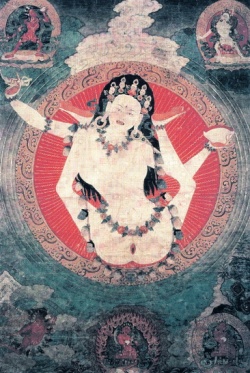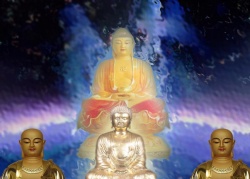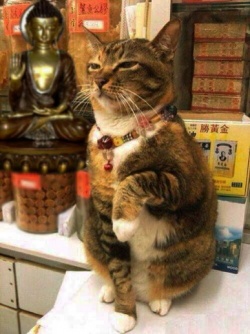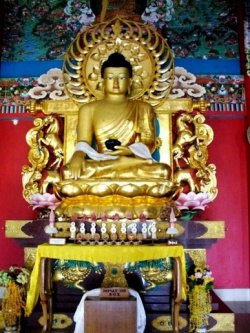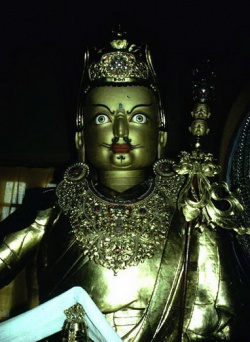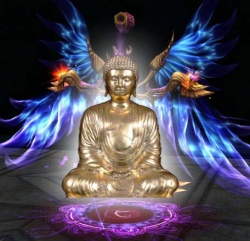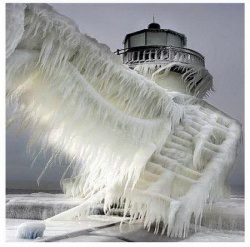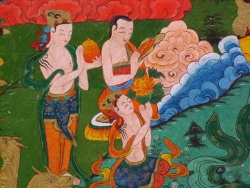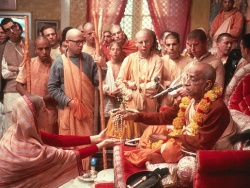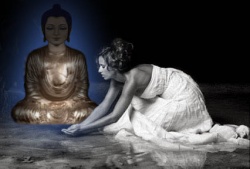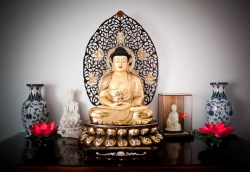THE SHADOW OF THE DALAI LAMA: SEXUALITY, MAGIC AND POLITICS IN TIBETAN BUDDHISM; Kalachakra: The Inner Processes
So far we have only described what takes place in the external world of the rituals. But the perceivable tantric stage has its correspondences in the “inside” of the yogi, that is, in his consciousness and what is called his mystic body. We now wish to examine this “internal theater” more closely. It runs in parallel to the external events.
An anatomically trained person from the twenty-first century requires a godly portion of tolerance to gain a familiarity with the concepts of tantric physiology, then for the tantras the body consists of a network of numerous larger or smaller channels through which the life energies flow. These are also known as “veins” or “rivers” (nadi, rtsa). This dynamic body structure is no discovery of Vajrayana, rather it was adopted from pre-Buddhist times. For example, we can already find it in the Upanishads (ninth century B.C.E.).
Three main channels are considered to be the central axis within the subtle-physical system of a person; these run from the lower spine to the head. They are, like everything in the tantras, assigned a gender. The left channel is called lalana (or ida, kyangma, da-wa), is masculine, its symbol is the moon and its element water. The right, “feminine” channel with the name pingala (or roma, nyi-ama) is linked to fire and the sun, since both are also seen as feminine in the Buddhist tantras. We can provisionally describe the central channel (avadhuti or susumna, ooma, ) as being androgynous. It represents among other things the element of space. All of the life energies are moved through the channels with the help of winds — by which the Tantric means various forms of breathing.
In a simplified depiction (such as is to be found in most commentaries), the left, masculine channel (lalana) is filled with white, watery semen, the right-hand, feminine channel (rasana) with red, fiery menstrual blood. The main channel in the middle, in contrast, is originally empty. Via sacred, in part extremely painful, techniques the yogi succeeds in pressing the substances from both side channels into the avadhuti, the main channel. The mixture (sukra) thus created now flows through his entire body as enlightenment energy body and transforms him into an androgynous “diamond being”, who unites within himself the primary energies of the masculine and the feminine.
All three channels pass through five energy centers which are to be found in the body of the yogi, which are known as chakras (wheels) or “lotus circles”. In Tibetan Buddhism, the count begins with the navel chakra and leads via the heart, throat, and forehead chakras to the highest thousandfold lotus at the crown of the skull. Of great importance for the tantric initiation is the equation of the individual “energy wheels” with the five elements: navel = earth; heart = water; throat = fire; forehead = air (wind); highest lotus (crown of skull) = space (ether). Likewise, the chakras are apportioned to the various senses and sense objects. In addition to this there are numerous further assignments of the lotus centers (chakra), as long as these can be divided into groups of five: the five “blisses” similarly count among these, likewise the five meditation Buddhas with their wisdom consorts, and the five directions.
Fine energy channels extend from the “wheels” and, like the physiological nervous system, branch through the entire human body. The tantras describe an impressive total of 72,000 fine channels, which together with the lotus centers and the three main channels form the “subtle” body of the yogi. In an “ordinary mortal” this network is blocked. The energies cannot flow freely, the chakras are “dead”, the “wheels” are motionless, the perception of spiritual phenomena limited. One also speaks of a “knotting”.
Now it is the first task of the yogi to untie these knots in himself or in his pupil, to free and to clean the blocked channels in all directions so as to fill the whole body with divine powers. The untying of the “knots” is achieved in the Guhyasamaja Tantra through the blocking off of the two side channels (lalana and pingala), in which the energies divided according to their sexual features normally flow up and down, and the introduction of the masculine and feminine substances into the avadhuti (the middle channel) (Dasgupta, 1974, p. 155). In the original Kalachakra texts (see footnote) the anatomy of the channels is much more complicated. [1]
The tantric dramaturgy is thus played out between three protagonists within the yogi — the masculine, the feminine, and the androgynous principle. Correspondingly, the three main energy channels reflect the tantric sexual pattern with the lalana as the man, the pingala as the woman, and the avadhuti as the androgyne. The lotus centers (chakras) are the individual stage sets in which the plot unfolds around the relationship between this trinity. Thus, if the microcosmic, “inner” world of events of the tantra master is supposed to square with the external, already described ritual actions, then we must rediscover the climaxes of the external performance in his “internal” one: for example, the tantric female sacrifice, the absorption of gynergy, the creation of androgyny, the destruction and the resurrection of all body parts, and so forth. Let us thus inspect these “internal” procedures more closely.
The Candali:
The Kalachakra Tantra displays many parallels with the Hindu Kundalini yoga. Both secret doctrines require that the yogi’s energy body, that is, his mysto-magical channels and chakras, be destroyed through a self-initiated internal fire. The alchemic law of solve et coagole ("dissolve and rebuild”) is likewise a maxim here. We also know of such phoenix-from-the-ashes scenarios among the occidental mystics. For our study it is, however, of especial interest that this “inner fire” carries the name of a woman in the Time Tantra. The candali — as it is called — refers firstly to a girl from the lowest caste, but the Sanskrit word also etymologically bears the meaning of ‘fierce woman’ (Cozort, 1986, p. 71). The Tibetans translate “candali” as ‘the hot one’ (Tum-mo) and take this to mean a fiery source of power in the body of a tantra adept.
The candali thus reveals itself to be the Buddhist sister of the Hindu fire-snake (kundalini), which likewise lies dormant in the lowest chakra of a yogi and leaps up in flames once it is unchained. But in Buddhism the destructive aspect of the inner “fire woman” is far more emphasized than her creative side. It is true that the Hindu kundalini is also destructive, but she is also most highly venerated as the creative principle (shakti): “She is a world mother, who is eternally pregnant with the world. ... The world woman and Kundalini are the macrocosmic and microcosmic aspects of the same greatness: Shakti, who god-like weaves and bears all forms” (Zimmer, 1973, p. 146).
With regard to the bodily techniques which are needed to arouse the kundalini, these vary between the cultural traditions. The Buddhist yogi, for example, unleashes the inner fire in the navel and not between the anus and the root of the penis like his Hindu colleagues. The candali flares up in his belly and, dancing wildly, ascends the middle energy channel (avadhuti). One text describes her as “lightning-fire”, another as the “daughter of death” (Snellgrove, 1959, p. 49). Then, level for level, the “hot one” burns out all the adept’s chakras. The five elements equated with the energy centers are destroyed in blazing heat. Starting from below, firstly the earth is burned up in the region of the navel and transforms itself into water in the heart chakra. Then the water is burnt out and disintegrates in fire in the throat. In the forehead, with the help of the candali the air consumes the fire, and at the crown of the skull all the elements vanish into empty space. At the same time the five senses and the five sense objects which correspond to the respective lotus centers are destroyed. Since a meditation Buddha and his partner inhabit each chakra, these also succumb to the flames. The Kalachakra Tantra speaks of a “dematerialization of the form aggregate” (Cozort, 1986, p. 130).
Lastly the candali devours the entire old energy body of the adept, including the gods who, in the microcosmic scheme of things, inhabit him. We must never forget that the tantric universe consists of an endless chain of analogies and homologies and links between all levels of being. Hence the yogi believes that by staging the destruction of his imperfect human body he simultaneously destroys the imperfect world, and that usually with the best intentions. Thus, Lama Govinda describes with ecstatic enthusiasm the five stages of this fascinating micro-macrocosmic apocalypse: “In the first, the susumna (the middle channel) with the flame ascending within it is imagined as a capillary thin as a hair; in the second, with the thickness of a little finger; in the third, with the thickness of an arm; in the fourth, as broad as the whole body: as if the body itself had become the susumna (avadhuti), a single fiery vessel. In the fifth stage the unfolding scenario reaches its climax: the body ceases to exist for the meditator. The entire world becomes a fiery susumna, an endless storm-whipped ocean of fire” (Govinda, 1991, 186).
But what happens to the candali, once she has completed her pyrotechnical opus? Does she now participate as an equal partner with the yogi in the creation of a new universe? No — the opposite is true! She disappears from the tantric stage, just like the elements which were destroyed with her help. Once she has vaporized all the lotus centers (chakras) up to the roof of the skull, she melts the bodhicitta (male seed) stored there. This, on account of its “watery” character, possesses the power to extinguish the “fire woman”. She is, like the human karma mudra on the level of visible reality, dismissed by the yogi.
In the face of this spectacular volcanic eruption in the inner bodily landscape of the tantra master we must ask what the magic means might be which grant him the power to ignite the candali and make her serve his purpose. Several tantras nominate sexual greed, which brings her to the boil. The Hevajra Tantra speaks of the “fire of passion” (Farrow and Menon, 1992, p. xxix). In another text “kamic fire” is explicitly mentioned (Avalon, 1975, p. 140). The term refers to the Hindu god Kama, who represents sexual pleasure. Correspondingly, direct reference is made to the act of love in a further tantric manual, where it can be read that “during sexual intercourse the Candali vibrates a little and great heat arises” (Hopkins, 1982, p. 177).
The equation of the sexual act with a fire ritual can be traced to the Vedas, and was later adopted by Tantric Buddhism. There the woman is referred to as the “sacrificial fire, her lower portion as the sacrificial wood, the genital region as the flame, the penetration as the carbon and the copulation as the spark” (Bhattacharyya, 1982, p. 124). From a Vedic viewpoint the world cannot continue to exist without a fire sacrifice. But we can also read that “the fire offering comes from union with the female messengers (dakinis)" — this from Tsongkhapa, the founder of the Tibetan Yellow Hat school (Shaw, 1994, p. 254).
In his classic, Yoga and the Geheimlehren Tibets (Yoga and the Secret Teachings of Tibet), Evans-Wentz described an especially impressive scene concerning the “kindling” of the candali. Here the “fire woman” is set aflame through a meditation upon the sun. After the master has required of his pupil that he visualize the three main channels, the chakras, and the “empty form” of a yogini, the exercise should continue as follows: “At this point in the performance you should imagine a sun in the middle of each palm and the sole of each foot. Then see these suns placed opposite one other. Then imagine a sun at the meeting of the three main psychic nerves [the main channels) at the lower end of the reproductive organ. Through the influence upon one another of the suns at your hands and feet, a flame is kindled. This fire ignites the sun beneath the navel. ... The whole body catches fire. Then when breathing out imagine the whole world to be pervaded by the fire in its true nature” (Evans-Wentz, 1937, p. 154). The inner unleashing of the candali in the body of the yogi is so unique that it raises many still unanswered questions which we can only consider step by step in the course of the following chapter: Why must it be a woman and not a man who flames up in the belly of the tantra master? Why is the woman, who is linked with the element water in most cultures, equated with fire here? Why is the candali so aggressive and destructive, so enraged and wild instead of mild, constructive, and well-balanced? But above all we must ask ourselves why the adept needs to use a real girl in order to ignite the “inner woman” in his own body? Is there perhaps a connection between the external woman and the inner woman, the karma mudra and the candali?
We shall only address these questions briefly here, pointwise as it were, in order to treat them in more detail in the course of the text. As we have already said, the origin of the candali lies in the Hindu kundalini snake, of which Heinrich Zimmer says: “The snake embodies the world- and body-developing life force, it is a form of the divine world-effecting force (shakti).” (Zimmer, 1973, p. 141). Life, creation, world, power: kundalini or candali are manifestations of the one and the same energy, and this is seen in both Hinduism and Buddhism as female. Zimmer therefore explicitly refers to the mystic snake as the “world woman” (Zimmer, 1973, p. 146). Corresponding descriptions of the candali are likewise known. The Buddhist yogi, whose attitude towards the world of appearances is extremely hostile, makes woman and the act of birth responsible for the terrible burden of life. For him, “world” and “woman” are synonymous. When, in his imagination, he burns up a woman within himself, then he is with this pyromaniacal act of violence symbolically casting the “world woman” upon the pyre. But this world likewise includes his old bodily and sensory aggregates, his psychological moods, and his human structures of awareness. They all become victims of the flames. Only once he has destroyed the existing universe, which suffers under the law of a woman, in an inferno, can he raise himself up to be a divine ruler of the universe.
Thus the assignation of the feminine to the fiery element imputed by Tantrism proves itself upon closer examination to be a symbolic manipulation. Everything indicates that in Indian culture too, woman was and is fundamentally associated with water and the moon rather than with fire and the sun as is claimed in the tantras. In non-tantric Indian cults (Vedic, Vishnuite) the classic assignments of the sexes have completely retained their validity. Hence, the ignition of the “fire woman” concerns an “artificial” experiment which runs contrary to the cultural norms; what the European alchemists referred to as the “production of burning water”. Water — originally feminine — is set on fire by the masculine potency of the flame and then becomes destructive. We shall have to show later that the candali is also to be symbolically understood as no more than such an ignited water energy. The water serves in this instance as a type of fuel and “explodes” as the ignited feminine principle in the service of androcentric strategies of destruction. Such a clever idea can only be derived from the tantric law of inversion which teaches us that a thing arises from its opposite. As the Candamaharosana Tantra thus says, “Women are the supreme fire of transformation” (Shaw, 1994, p. 39).
If one assumes that the feminine catches fire against its will in the Kalachakra ritual, then one can understand why the candali reacts so aggressively and destructively. Perhaps, once she has flared up, she instinctively detects that the entire procedure concerns her systematic destruction? Perhaps she also has an inkling of the perfidious intentions of the yogi and like a wild animal begins to destroy the elementary and sensory aggregates of her tormentor in the hope of thus exterminating him and freeing herself? Confronted with her obvious success in the bodily destruction of the patriarchal archenemy, she becomes maddened by power, unaware that she thereby only serves her enemy as a tool. For precisely what the tantric adept wants is to attain a state in which he still exists only as pure consciousness. His first goal is therefore the complete dematerialization of his human body, down to the last atom. For this he needs the fiery rage of the candali, who represents nothing other than the hate of a goddess incapacitated by patriarchy.
But it could also be the opposite, that the candali falls into the grip of the “consuming fire”, that mystic fire of love which burns women up when they celebrate the “sacred wedding” with their god. Christian nuns often describe the unio mystica with Christ, their heavenly husband, with metaphors of fire. In the case of Theresa of Avila, the flames of love are linked with an unequivocally sexual symbolism. The words with which she depicted the divine penetration of her love have become famous: “I saw Him with a long lance of gold, and its tip was as if made of fire, it seemed to me as if he repeatedly thrust it into my heart and it penetrated to my very entrails! .... The pain was so great that I had to groan, and yet the sweetness of this excessive pain was such that I could not wish to be freed of it” (quoted by Bataille, 1974, p. 220). A woman, who completely and totally surrenders herself to her yogi with her whole being, who opens to him the love of her entire heart, she too can burst into flames. Hate and mystic love are both highly explosive substances.
Regardless of what sets the feminine on fire, the pyromaniacal drama which is played out on this inner stage is from start to finish under the control of the yogi as the “master of the fire”. He never surrenders this position as “director”. Two beings are always sacrificed at the end of the tantric theater: the old energy body of the vajra masters and the ignited candali herself. She is the tragic inner symbol of the “tantric female sacrifice”, which — as we have explained above — was in the outside world originally executed upon a fire altar.
But here too the already often-repeated warning applies: Woe betide the adept who loses control over the kundalini or candali. For then she becomes a “terrible vampire, like an electric shock”, the “pure potency of death”, which exterminates him (Evola, 1926, p. 232).
The “drop theory” as an expression of androgyny:
Let us now following the act of destruction examine the inner act of creation in the mystic body of the yogi as it is described in the various tantras, especially the Kalachakra Tantra. We have already considered the event where the “fire woman” (candali) reaches the inner roof of the yogi’s skull and melts the bodhicitta (semen) there. This latter is symbolically linked with water and the moon. Its descent is therefore also known as the “way of the moon”, whilst the ascent of the candali goes by the name of the “sun way”. The bodhicitta is also called bindu, which means ‘point’, ‘nil’, ‘zero’, or ‘drop’. According to the doctrine, all the forces of pure consciousness are collected and condensed into this “drop”, in it the “nuclear energy of the microcosm” is concentrated (Grönbold, Asiatische Studien, p. 33).
After the channels and chakras have been cleansed by the fire of the candali, the bodhicitta can flow down the avadhuti (the middle channel) unrestricted. At the same time this extinguishes the fire set by the “fire woman”. Since she is assigned the sun and the “drops of semen” the masculine moon, the lunar forces now destroy the solar ones. But nevertheless at the heart of the matter nothing has been changed through this, since the descent of the “drop”, even though it involves a reversal of the traditional symbolic correspondence, is, as always in the Buddhist tantras, a matter of a victory of the god over the goddess.
Step by step the semen flows down the central channel, pausing briefly in the various lotus centers and producing a feeling of bliss there, until it comes to rest in the tip of the aroused penis. The ecstatic sensations which this progress evokes have been cataloged as “the four joys”. [2]
This descending joy gradually increases and culminates at the end in an indescribable pleasure: “millions upon millions of times more than the normal emission [of semen]" (Naropa, 1994, p. 74). In the Kalachakra Tantra the fixation of orgiastic pleasure which can be attributed to the retention of semen is termed the “unspilled joy” or the “highest immovable” (Naropa, 1994, p. 304, 351).
This “happiness in the fixed” is in stark opposition to the “turbulent” and sometimes “wild” sex which the yogi performs for erotic stimulation at the beginning of the ritual with his partner. It is an element of tantric doctrine that the “fixed” controls the “turbulent”. For this reason, no thangka can fail to feature a Buddha or Bodhisattva who as a non-involved observer emotionlessly regards the animated yab–yum scenes (of sexual union) depicted or impassively lets these pass him by, no matter how turbulent and racy they may be. We also do not know of a single illustration of a sexually aroused couple in the tantric iconography which is not counterbalanced by a third figure who sits in the lotus posture and observes the copulation in total calm. This is usually a small Buddha above the erotic scene. He is, despite his inconspicuousness the actual controlling instance in the sexual magic play — the cold, indifferent, serene, calculating, and mysteriously smiling voyeur of hot loving passions.
The orgiastic ecstasy must at any price be fixed in the mystic body of the adept, he may never squander his masculine force, otherwise the terrible punishments of hell await him. “There exists no greater sin than the loss of pleasure”, we can read in the Kalachakra commentary by Naropa (Naropa, 1994, p. 73, verse 135). Pundarika also treats the delicate topic in detail in his commentary upon the Time Tantra: “The sin arises from the destruction of pleasure, ... a dimming then follows and from this the fall of the own vajra [[[Wikipedia:phallus|phallus]]], then a state of spiritual confusion and an exclusive and unmediated concern with petty things like eating, drinking and so on” (Naropa, 1994, p. 73). That is, to put it more clearly, if the yogi experiences orgasm and ejaculation in the course of the sexual act then he loses his spiritual powers.
Since the drops of semen symbolize the “moon liquid”, its staged descent through the various energy centers of the yogi is linked to each of the phases of the moon. Beneath the roof of the skull it begins as a “new moon”, and grows in falling from level to level, to then reach its brightest radiance during its sixteenth phase in the penis. In his imagination the yogi fixates it there as a shining “full moon” (Naropa, 1994, p. 72, 306).
Logically, in the second, counterposed sequence the “ascent of the full moon” is staged. For the adept there is no longer a waning moon. Since he has not spilled his seed, the full shining abundance of the nightly satellite remains his. This ascendant triumphal procession of the lunar drop up through the middle channel is logically connected to an even more intensive pleasure than the descent, since “the unspilled joy” starts out in the penis as a “full moon” and no longer loses its full splendor.
During its ascent it pauses in every chakra so as to conjure up anew the “highest bliss” there. Through this stepwise ecstatic lingering in the lotus centers the yogi forms his new divine body, which he now refers to as the “body of creation” (Naropa, 1994, p. 311). This is first completed when the “full-moon drop” reaches the lotus in the forehead.
Sometimes, even if not all the time, in wandering through the four pleasure centers the “drop” encounters various goddesses who greet it with “diamond” song. They are young, tender, very beautiful, friendly, and ready to serve. The hissing wildness and the red wrath of the candali is no more!” May you,” the beauties call, “the diamond body, the revolving wheel that delights many beings, the revealer of the benefit of the Buddha aim and the supreme-enlightenment aim, love me with passion at the time of passion, if you, the mild lord wish that I live” (Wayman, 1977, p. 300). Such erotic enticements lead in some cases to an imaginary union with one of the goddesses. But even if it doesn’t come to this, the yogi must in any case keep his member in an erect state during the “ascent of the full moon” (Naropa, 1994, p. 75).
In several Kalachakra commentaries the ecstatic model of the rise and fall of the white moon-drops within the mystic body of the adept is determined by the triumph of the male bodhicitta alone. In the first, falling phase it destroys the fiery candali and leads her into emptiness, so to speak, since the bindu (drop) also means “nothing”, and has control over the power of dissolution. In the second phase the drop forms the sole cosmic building block with which the new body of the yogi will subsequently be constructed. In this view there is thus now talk of the male seed alone and not of a mixture of the semen virile and semen feminile. In his Kalachakra commentary Naropa writes explicitly that it is the masculine moon which produces the creation and the feminine sun which brings about the dissolution (Naropa, 1994, p. 281). One must thus be under the impression that after the extinguishing of the candali there are no further feminine elements existing in the body of the yogi, or, to put it in the words of the popular belief which we have already cited, that sperm rather than blood flows in his veins. But there are other models as well.
Daniel Cozort, for example, in his contemporary study of the Highest Yoga Tantra, speaks of two fundamental drops. The one is white, masculine, lunar, and watery, and is located beneath the roof of the skull; the other is red, feminine, solar, and fiery, and located in the region of the genitals (Cozort, 1986, p. 77). The “four joys from above” are evoked when the white drop flows from the forehead via the throat, heart, and navel to the tip of the penis. The “four joys from below” arise in reverse, when the red drop streams upwards from the base of the spine and through the lotus centers. There are a total of 21,600 masculine and the same number of feminine drops stored in the body of the yogi. The adept who gets them to flow thus experiences 21,600 moments of bliss and dissolves 21,600 “components of his physical body”, since the drops effect not just pleasure but also emptiness (Mullin, 1991, p. 184).
The process is first completed when two “columns of drops” have been formed in the energy body of the adept, the one beginning above, the other from below, and both having been built up stepwise. At the end of this migration of drops, “a broad empty body, embellished with all the markings and distinguishing features of enlightenment, a body which corresponds to the element of space [is formed]. It is 'clear and shining', because it is untouchable and immaterial, emptied of the earthly atomic structure”, as the first Dalai Lama already wrote (Dalai Lama I, 1985, p. 46).
A further version (which also applies to the Time Tantra) introduces us to “four” drops of the size of a sesame seed which may be found at various locations in the energy body and are able to wander from one location to another. [3] Through complicated exercises the yogi brings these four principle drops to a standstill, and by fixating them at certain places in the body creates a mystic body.
The anatomy of the energy body becomes even more complicated in the Kalachakra commentary by Lharampa Ngawang Dhargyey when he introduces another “indestructible drop” in the heart of the yogi in addition to the four drops mentioned above. This androgynous bindu is composed of the “white seed of the father” in its lower half together with the “red seed of the mother” in the upper. It is the size of a sesame seed and consists of a mixture of “extremely fine energies”. The other lotus centers also have such “bisexual” drops, with mixtures of varying proportions, however. In the navel, for example, the bindu contains more red seed than white, in the forehead the reverse is true. One of the meditation exercises consists in dissolving all the drops into the “indestructible heart drop”.
Luckily it is neither our task, nor is it important for our analysis, to bring the various drop theories of tantric physiology into accord with one another. We have nonetheless made an effort to do so, but because of the terminological confusion and hairsplitting in the accessible texts, were left with numerous insoluble contradictions. In general, we can nevertheless say that we are dealing with two basic models.
In the first the divine energy body is constructed solely with the help of the white, masculine bodhicitta. The feminine energy in the form of the candali assists only with the destruction of the old human body.
In the second model the yogi constructs an androgynous body from both red and white, feminine and masculine bodhicitta elements.
The textual passages available to us all presume that the masculine-feminine drops can already be found in the energy system of the adept before the initiation. He is thus regarded from the outset as a bisexual being. But why does he then need an external or even an imagined woman with whom to perform the tantric ritual? Would it in this case not be possible to activate the androgyny (and the corresponding drops) apparently already present in his own body without any female presence? Probably not! A passage in the Sekkodesha, which speaks of the man (khagamukha) possessing a channel filled with semen virile and the woman (sankhini) a channel filled with semen feminile, leads us to suspect that the yogi first draws the red bodhicitta or the red drop off from the karma mudra (the real woman), and that his androgyny is therefore the result of this praxis and not a naturally occurring starting point.
This view is also supported by another passage in the Kalachakra Tantra, in which the sankhini is mentioned as the middle channel in the mystic body of the yogi (Grönbold, 1969, p. 84). Normally, the menstrual blood flows through the sankhini and it may be found in the lower right channel of the woman (Naropa, 1994, p. 72). In contrast, in the body of the yogi before the sexual magic initiation no “menstrual channel” whatever exists. Now when this text refers to the avadhuti (the middle channel) of the tantra master as sankhini, that can only mean that he has “absorbed” the mudra’s red seed following union with her.
We must thus assume that before the sexual magic ritual the red bodhicitta is either completely absent from the adept’s body or, if present, then only in small quantities. He is forced to steal the red elixir from the woman. The extraction technique described above also lends support to this interpretation.
Regardless of whether the Tibetan Lamas are convinced of the overwhelming superiority of their theories and practices, there is in principle no fundamental difference between Hindu and Buddhist techniques (Snellgrove, 1987, vol. 1, 294). Both systems concern the absorption of gynergy and the production of a microcosmic/ masculine/androgyne/divine body by the yogi. There are, however, numerous differences in the details. But this is also true when one compares the individual Buddhist tantras with one another. The sole teaching contrary to both schools which one could nominate would be total “Shaktism”, “which elevates the goddess above all gods” (von Glasenapp, 1936, p.125).
Excursus: The mystic female body:
But is it at all possible to apply the mystic physiology described in the Buddhist tantras to a woman? Or is the female energy body subject to other laws? Does the kundalini also slumber in the perineum of a woman? Does a woman carry her red drop in her forehead? Where can the white bodhicitta be found in her and what are its movements? Are the two side channels within her arranged just like those in a man or are they reversed? Why does she also work with fire in her body and not with water?
There are only very few reports about the mystic body of the woman, and even fewer instructions. The books on praxis which we have been able to consult are all drawn from the Chinese cultural sphere. The Frenchwoman, Catherine Despeux, has collected some of these in a historical portrait (Immortelles de la Chine Ancienne). A practical handbook by Mantak and Maneewan Chia is available; it is subtitled The Secret Way to Female Love Energy.
Generally, these texts allow us to say that the spiritual energy experiences undergone by women within their mystic bodies follow a different course to those for men described above. The two poles between which the “tantric” scenario is played out in the woman are not the genitals and the brain as in the case of a man, but rather the heart and the womb. Whilst for the yogi the highest pleasure is first concentrated in the tip of the penis, from where it is drawn up to the roof of the skull, the woman experiences pleasure in the womb and then a “mystic orgasm” in the heart, or the energy emerges from the heart, sinks down to the womb and then rises up once more into the heart. “The sudden opening of the heart chakra causes an ecstatic experience of illumination; the heart of the woman becomes the heart of the universe” (Thompson, 1981, p. 19).
According to Chinese texts, for example, the red seed of the woman arises between her breasts, and from there flows out into the vagina and is, unlike the male seed in Vajrayana, not to be sought under the roof of the skull (Despeux, 1990, p. 206). The techniques for manipulation of the energy body which result from this are therefore completely different for men and women in Taoism.
Without further examining the inner processes in the female body, what has been said in just a few sentences already indicates that an undifferentiated transferal of Vajrayana techniques to the female energy body must have fateful consequences. It thus amounts to a sort of rape of the feminine bodily pattern by the masculine physique. It is precisely this which the Fourteenth Dalai Lama encourages when he — as in the following quotation — equates the internal processes of a woman with those of a man. “Some people have confirmed that the white element is also present in women, although the red element is stronger in them. Therefore the praxis in the previously described tantric meditation is the same for women; the white element sinks in exactly the same manner and is then drawn back up” (Varela 1997, p. 154).
Should a woman adopt androcentric yoga techniques then her sexual distinctiveness disappears and she is transformed in energy terms into a man. In so doing she thus fulfills the sex change requirement of Mahayana Buddhism which is supposed to make it possible for a woman to already in this lifetime be reincarnated as men — at least in regard to their mystic bodies.
Spiritual feminists (and there are a number of these) who believe they can overcome their female impotence by copying the male yoga techniques of Tantrism become caught in the most insidious and cynical trap which the patriarchy was able to set. In the delusion that by unchaining the candali within their own body they can shake off the androcentric yoke, they unwittingly employ sexual magic manipulations which effect their own dissolution as gendered beings. They perform the “tantric female sacrifice“ upon themselves without knowing, and set fire to the stake at which they themselves are burned as a candali or a witch (dakini).
The method or the manipulation of the divine:
But let us return again to the male tantra techniques. The “method” which the adept employs to produce his androgynous body is referred to as the “Yoga with Six Limbs” (Sadanga yoga). This system of teaching is valid for both the Kalachakra Tantra and the Guhyasamaja Tantra. It has been referred to as the highest of all techniques in Vajrayana Buddhism. Fundamentally, sexual intercourse with a woman and the retention of semen are necessary in performing this yoga. Of course, if a partner cannot be found, masturbation can also be employed (Grönbold, Asiatische Studien, p. 34). [4]
The six stages of Sadanga yoga are called (1) Individual retreat (pratyahara); (2) Contemplation (dhyana); (3) Breath control (pranayama); (4) Fixation or retention (dharana); (5) Remembering (anusmrti); and (6) Unfolding or enlightenment (samadhi). We shall briefly present and interpret the six levels.
1. Pratyahara (individual retreat): The yogi withdraws from all sensory abilities and sense objects back into himself; he thus completely isolates himself from the external world. It is also said that he locks the doors of the senses and draws the outside winds into himself so as to concentrate them into a drop (Cozort, 1986, p. 124). The meditation begins at night and must be conducted in complete darkness. The American tantra interpreter, Daniel Cozort, recommends the construction of a “light-proof cabin” as an aid. The yogi rolls back his eyes, concentrates on the highest point of his middle energy channel and envisions a small blue drop there. During this exercise the ten photisms (light and fire signs) arise in the following order before his inner eye as forebodings of the highest enlightenment, the infinite clear light. (1) Smoke; (2) a ray of light; (3) glow worms; (4) the light of a lamp — these are the first four phenomena which are also assigned to the four elements and which Sadanga yoga describes as “night signs, since one still lives in darkness so to speak, as in a house without windows” (Grönbold, Asiatische Studien, p. 36). The remaining six phenomena are called the “day signs”, because one now, “as it were, looks into a cloudless sky” (Grönbold, Asiatische Studien, p. 35). They begin with (5) the steadfast light, followed by (6) fire, which is considered to be the shine of emptiness, (7) moonlight and sunshine, (8) the shine of the planet Rahu, which is compared to a black jewel. Then, in (9) an atom radiates like a bright bolt of lightning, and lastly (10) the great drop appears, which is perceived as “a shining of the black orb of the moon” (Grönbold, Asiatische Studien, p. 35). Grönbold interprets the fact that a “dark light” is seen at the end as an effect of bedazzlement, since the light phenomena are now no longer comprehensible for the yogi (Grönbold, Asiatische Studien, p. 35). [5]
2. Dhyana (contemplation): On the second level of Sadanga yoga the adept through contemplation fixes beneath the roof of the skull his thoughts and the ten day and night signs. This contemplation is characterized by five states of awareness: (1) wisdom; (2) logic; (3) reflection; (4) pleasure; and (5) imperturbable happiness. All five serve to grant insight into the emptiness of being (Grönbold, Asiatische Studien, p. 32). When he has stabilized the signs, the yogi has attained the purity necessary to ascend to the next level. He now possesses the “divine eye” (Naropa, 1994, p. 219).
3. Pranayama (wind or breath control): Breath, air, and wind are synonymous in every form of yoga. The energies internal to the body which flow through the subtle channels are called winds. A trained adept can control them with his breathing and thus has the ability to reach and to influence all 72,000 channels in his body by inhaling and exhaling. The energy wind generally bears the name prana, that is, pure life force. In the Kalachakra school the opinion is held that prana is the primordial wind from which the nine main winds are derived (Banerjee, 1959, p. 27). Time is also conceived of as a coming and going of breath. Accordingly one who has his breathing under control also has mastery over time. He becomes a superhuman being, that “knows [about] the three times”: about the future by inhaling, about the past by exhaling, and about the eternal present by holding his breath (Grönbold, Asiatische Studien, p. 29).The wind, as the yogi’s highest instrument of control, dominates the entire scenario, sometimes propelling the mystic indestructible drops through the channels, sometimes pushing through the knots in the chakras so that the energies can flow freely, sometimes burning up the yogi’s bad karma via breathing exercises. There are numerous catalogs of the various types of wind. Coarse and subtle, secondary and primary, ascending and descending winds all waft through the body. In the Kalachakra Tantra a total of ten principle types of breath wind are distinguished. The high point in pranayama yoga consists in the bringing of the winds found in the right and left side channels into the central channel (avadhuti). In an ordinary person, prana pulses in both outer channels, of which one is masculine and the other feminine. Therefore, from a tantric point of view he still lives in a world of opposites. Through the activation of his middle, androgynous channel the yogi now believes he can recreate the original bisexual unity.
4. The fourth exercise is called dharana (fixation). The breath wind is fixated or retained firstly within the middle channel, then in the individual chakras. The emotions, thoughts, and visions of particular deities are also fixed through this. Throughout this exercise the yogi’s penis must remain constantly erect. He is now the “lord of the winds” and can let the energies wander through his body at will in order to then fix them in particular locations. This also applies to the entry of the breath into the drops, wherever these are to be found. Although the adept now controls the ten main winds, at this stage his body is not yet purified. Therefore he concentrates the energy in the navel chakra and combines it with “the drop of sexual ecstasy”. It is this procedure which first results in the ignition of the candali.
5. The entrance of the “fire woman” (candali) dominates the scenario of the fifth yoga, known as anusmriti. Oddly, this has the meaning of ‘recollection’ (Grönbold, 1969, p. 89). Why is the catching sight of the candali “in the body and in the sky” linked to a mystic reminiscence? What is it that the yogi remembers? Probably the “original unity”, the union of god and goddess.
6. In the last stages of Sadanga yoga the adept reaches samadhi (enlightenment or unfolding), the “indestructible bliss”. This state is also equated with the “vision of emptiness” (Wayman, 1983, p. 39). All winds, and thus all manifestations of existence as well, are now brought to a standstill — peace reigns among the peaks. For a night and a day the yogi suspends the 21,600 breaths, that is, he no longer needs to breathe. His material bodily aggregates are dissolved. Complete immobility occurs, all sexual passions vanish and are replaced by the “motionless pleasure” (Naropa, 1994, p. 219).
Since the flow of time depicts nothing other than the currents of the energy winds in the body, the adept has, by stilling these, elevated himself beyond the cycle of time and become its absolute master. Back at the third level of the exercises, during pranayama, he had already won control over the flow of time, but he only halts it when he attains the state of samadhi.
It is astonishing that all six stages of Sandanga yoga should be performed during sexual union with a karma mudra (a real woman). But until it comes to this, many hours of preparation are needed. The inner photisms described also arise in the course of the sexual act.
For example, to press the masculine and feminine energy currents into the middle channel in pranayama, the adept employs drastic Hatha yoga practices, which are known as “the joining of the sun and moon breaths” (Evans-Wentz, 1937, p. 33). In translation ha means ‘sun’, and tha ‘moon’. Hatha, the combination of ha and tha, significantly means ‘violence’ or ‘violent exertion’ and thereby announces the element of violence in the sexual magic act (Eliade, 1985, p. 238). This consists of a sudden, jerking leap up during sexual intercourse accompanied by simultaneous pressure on the perineum with the hand or the heel. That such “methods” (upaya) are especially enticing and erotic for a “wisdom consort” (prajna) is something we would like to doubt. The lack of feeling, the coldness, the cunning, and the deep misogyny which lies behind these yoga techniques actually ought to hit the karma mudra in the eye at once. Yet in the arms of a godlike Lama she would only seldom dare to take her skeptical impressions seriously or even articulate them.
Sadanga yoga describes the Kalachakra Tantra “method” (upaya) to be employed during the higher and highest initiations. We are dealing here with an emotionless, “rational”, purely technical set of instructions for the manipulation of energies which are profoundly emotional, arousing, and instinctive — like love, eroticism, and sexuality. In the classic tantric polarity of “wisdom” (prajna) and “method” it is the latter which is covered by these yoga techniques. The yogi does not need to bother about anything else — wisdom, knowledge, or feelings. They are already to be found in the “prajna”, the feminine elixir which he can snatch from the woman by properly practicing Sandanga yoga. Now what is the result of this calculating and sophisticated sexual magic?
_______________
Footnotes:
[1] The Kalachakra Tantra distinguishes between an upper part to the three main channels and a lower one. Above, the following symbolic division is made: left — moon, masculine; right — sun, feminine; middle — Rahu, androgynous. Rahu is an imaginary planet which can cause a solar or lunar eclipse. The upper three energy flows thus possess a planetary character. The lower part is determined by the substances which can be found in the three channels before the yoga praxis: left — urine; right — semen; middle — excrement. This arrangement becomes more complicated owing to the fact that the upper and lower channels change their positions. The lalana (moon, upper left) appears below in the middle and is there filled with excrement. The pingala (sun, upper right) is linked to the lower left, urine-filled channel. Rahu, in the middle above, is found to the right below, as the sperm channel. The upper and lower channels also have different names and are filled with different substances in men and women, hence the lower right-hand channel is said to contain menstrual blood rather than semen in the female body (Naropa, 1994, pp. 274, 275). In the women the lower right channel bears the name sankhini and is filled with female seed; the lower right channel of the man is known as khagamukha and contains the semen virile (Naropa, 1994, p. 72). Martin Brauen’s graphical depiction of the channels in the Kalachakra Tantra (Brauen, 1992, p. 55) is admittedly logically consistent for a number of reasons — in that he shows the middle channel as continuous from top to bottom, for instance. However, it does not accord with the quoted textual passages from the Sekkodesha (Naropa, 1994, p. 72 ff.).
[2] The “first joy” takes effect in the forehead and stretches down to the throat chakra. The second reaches from there to the heart and bears the name “highest joy”, the third ends in the navel and is called the “special joy”. The fourth, the “inborn joy”, realizes itself in the tip of the penis (Cozort, 1986, p. 76).
[3] The first “drop of deep sleep” lies in the heart or at the tip of the penis. The second “drop of the dreaming state”, which is also known as the “drop of speech”, is likewise to be sought in the genital region or in the throat. The third “drop of the waking state” moves between the forehead and the navel. The fourth “drop of erotic ecstasy”, which is experienced during sexual intercourse between man and woman, may be found in the genitals or beneath the roof of the skull. It is also referred to as the “drop of transcendental wisdom” (Dhargyey, 1985, pp. 121,122).
[4] The Sadanga Yoga is not identical to the “Six Part Yoga of Naropa” which is far better known in the West. The Maha Siddha (Naropa) must nevertheless have known both types of yoga, since he refers to the Sadanga exercises in his commentary on the Kalachakra Tantra. In the original text of the Time Tantra (Sekkodesha) this yoga is only very briefly mentioned, in verses 115-119 of the fourth chapter. However, this brief passage has nothing to say about its fundamental importance, rather just that numerous specific documents exist to which the yogi can easily obtain access. Of these, many of these are in the meantime available in English or German translations. (See above all the works by Grönbold.)
[5] In contrast, alongside the four “night signs” mentioned above, Daniel Cozort mentions the following six “day signs”: (5) destructive fire; (6) the sun; (7) the moon; (8) the planet Rahu; (9) a stroke of lightning; and (10) the blue point (Cozort, 1986, p. 125). In the eleventh sign Kalachakra and Vishvamata reveal themselves in sexual union within the blue drop. The Sekkodesha calls this event the “universal, clear shining image” and speaks of an epiphany of the all-knowing Buddha, who shines “like the sun in water, unbesmirched, of every color, with all aspects, recognized as an expression of our own consciousness, without any objectivity” (Naropa, 1994, pp. 229, 254). Other texts specify still more photisms, but in all cases they concern pure fire and light meditations which the yogi has to successfully traverse.
